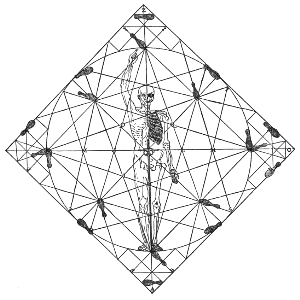
Fig. 1: Thibault's circle
Journal of Western Martial Art
February 2001
by Maestro Ramón Martínez
The Spanish School of Swordsmanship, "La Destreza," is the most misunderstood subject in the history of fencing. It has been misrepresented by fencing scholars for the past one hundred years as an ineffectual and artificial system of swordsmanship full of absurdities. The intent of this article and others to follow is to present a clearer and more accurate picture of what "La Destreza" is.
The principal obstacles to the comprehension of La Destreza are the geometry and philosophy that are the foundations of the school. These two aspects have been ridiculed and completely dismissed as totally incompatible with training for the practical management of the arma blanca (white arm). It is of vital importance to approach the treatises of the Spanish Masters with an understanding that these men were highly educated individuals. They bring to their writings a wealth of mathematical and scientific knowledge along with a philosophy replete with mystical thought. It is presumptuous and non-productive of fencing historians to dismiss the complex frame of reference from which this system was derived. The focus of this article will be to present the geometry in a more comprehensible form.
"La Destreza" can not be translated literally but can be interpreted as "high level art and skill." Don Jeronimo de Carranza is considered the father of the Spanish School and given the title "El Primer Inventor de La Sciencia de Las Armas" ("The First Inventor of the Science of Arms") by Don Luis Pacheco de Narvaez. He is referred to by this title not only by his students but by countless other masters as well. Carranza himself clearly states that he is the creator of this school. His teachings were carried on by his disciple and successor, Narvaez.
It was the belief of both Carranza and Narvaez, as well as all of the subsequent masters of the Spanish School, that science, which is irrefutable, can and must be applied to swordsmanship. Their aim was to use science to improve the art of the sword,thus proving the validity, effectiveness, and perfection of their system. The definition of science must be taken into account before continuing. Science is knowledge, as of general truths or particular facts, obtained and shown to be correct by accurate observation and thinking. The science of geometry is the best manner in which "La Destreza" can be set forth because it is incontestable, being demonstrated to be exact by proofs.
During this time period there was an interest in all things that were of classical origin. The science of mathematics, a major part of classical thought, was thoroughly studied in Spain during the intellectual movements towards humanism. "One of the most important of the great methodological achievements of the early Greek mathematicians was the development of the methods of analysis and synthesis, for these methods constitute the basic inferential procedure of Greek geometry. Analysis, according to the Greeks, commences with the assumption of what is to be proved and then proceeds backward by successive inferences to theorems or axioms or postulates generally accepted or previously proved. Synthesis is, of course, the reversal of this procedure, starting with the previously accepted or proved theorem and proceeding therefrom to the proof of the new theorem."[1] This way of thinking is clearly evident in Narvaez' use of the phrase, "conocimiento de la cosa por su causa" (understanding of the effect by its cause).
The question arises: What is the purpose of the study and application of geometry to swordsmanship? The importance and relevance can be seen in the study of geometry itself. From a text book on geometry;
"Plane geometry as usually taught has several primary objectives. The most important are: (1) to develop an understanding of the meaning and nature of mathematical proof; (2) to improve the quality of thinking in non-mathematical situations; (3) to further develop mathematical concepts of an arithmetic and algebraic nature; and (4) to provide an understanding of plane and space relationships for a better appreciation of nature and the arts as they apply to daily life."[2]Of particular relevance to the study of La Destreza are points two and four. Point two is key to training the swordsman to achieve a manner of thinking that will aid him in analyzing a given combative situation and act upon the circumstance in a logical manner. Geometry was used to train the swordsman to think logically, methodically, and unemotionally. It enabled the swordsman to develop a coolness and detachment necessary for the implementation of this scientific method. Point four is applicable to generalship as will be discussed later in this article.
In reference to the geometry of swordsmanship in "La Destreza" Don Luis Pacheco de Narvaez states; "Finalmente quiero que entedays, que el fin de poner La Destreza en demonstraciones, es para que procedays con mas conocimiento." (Finally, I wish you to comprehend that the end to which La Destreza is placed in demonstrations (proofs) is in order that one may proceed with more understanding.) What does Narvaez mean by this? Narvaez is clearly stating that the geometric proofs are set forth to enable the swordsman to see how the placements of the body, arm or sword are most effective in relationship to adversary's body, arm or sword. The proofs show how movement can be applied efficiently. When this is transferred into practical application the swordsman can proceed with conviction in the resulting success of the technique.
The stance, attack and defence, are all within a circular concept. All
fighting takes place within an imaginary circle on the ground. According
to Girard Thibault in his treatise Academie de l'Espee (1628),
the circle's diameter is determined by the length of the swordsman standing
straight with his heels together having his arm and index finger extended
over his head. The distance from the ground to the tip of his extended
index finger is the diameter of the circle. According to Carranza and Narvaez,
the "Diestro" as the swordsmen are called, assume an upright, semi-profiled
posture with the heels slightly apart. The arm is held straight forward
at shoulder level holding the sword with its blade parallel to the ground
and menacing the adversary. The points of the swords are held in front
of each other's sword hilt. This is what determined the diameter of the
circle.

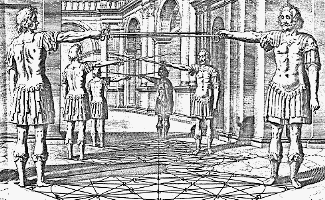
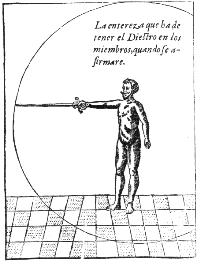
The supreme error that has been committed by modern fencing historians is to assume that the demonstrations in the treatises of the Spanish Masters were to be subscribed to literally in a combative situation. It is ridiculous to imagine that Spanish swordsmen stopped an armed confrontation, carefully measured a circle on the ground and then began the fight! Equally absurd would be the idea that a swordsman in those circumstances would ponder if he was properly stepping from point A on the circle to point B across chord AB of the circle.
Another erroneous assumption propagated by many fencing historians that needs to be corrected is their assertion that the circle is in a fixed location. The imaginary circle moves with the swordsmen as they engage in combat. La Destreza is fought in dynamic movement within the circle. The circumference of the circle is in the consciousness of the Diestro. It is well etched in the thought processes after years of theoretical and practical study.
Unlike other systems of swordsmanship La Destreza is based on movement and not solely on technique. What is meant by movement is specific actions of the weapon and body. Each technique (treta) in La Destreza is formed by a combination of movements that compose the technique. As in dancing each step is learned separately, and when performed there are enumerable combinations that create the dance. So it is in Spanish swordsmanship; the varied combinations of movements create techniques (tretas).
The contemporary Italian schools of swordsmanship focused mainly on set techniques. There are a variety of "Guards" that are merely static postures from which to launch an offensive or counter offensive action. The later modern fencing definition for the term "Guard" does not apply here, as these 16th-century positions did not guard the swordsman at all.
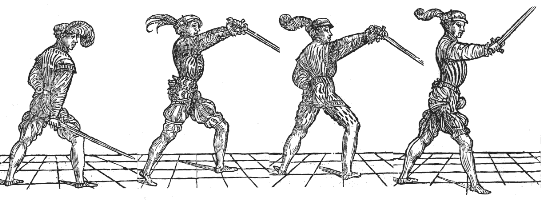
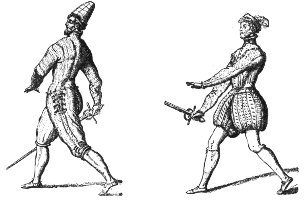
(It was not until the beginning of the seventeenth century that the concept of a position that actually "Guarded" the swordsman emerged in the writings of Ridolfo Capo Ferro in his treatise Gran Simulacro... (1610).)
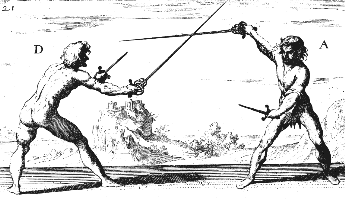
The swordsman will shift from one posture to another, looking for an opening in the adversary's defense or seizing an opportunity for an attack as the adversary is changing postures. The swordsman will also attack into an oncoming attack while closing the line of attack (time hits), also known as stesso tempo where the parry and the attack become one. In contrast La Destreza has only one posture, which is truly a defensive stance. A stance that keeps the adversary at bay by a continual threat with the sword's point is defensive. It creates a strategic problem for the adversary who must penetrate that line of defense to be able to attack effectively and do it with out injury to himself. An attack will not be met by a counter-attack as in the Italian Schools, but will be answered by moving to a defensive position while at the same time controlling the adversary's weapon with the Diestro's own weapon. This would seem to be the same as in the Italian Schools but it is not quite. The difference being that the Diestro secures his defensive position by moving away from an attack rather than attacking into an attack. It is similar to the manner in which a bullfighter deals with the attacking bull. As the animal attacks the bullfighter veers away at an angle, steps around from the onslaught, and thrusts the "banderillas" (long decorated darts) or "estoque" (sword) into the bull in one fluid sequence of movements that constitute this particular technique. To put it in simplistic terms, Italian swordsmen see that the best defense is counter attack into the oncoming attack.
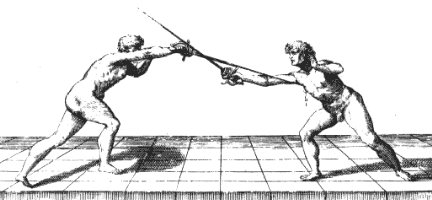
(Salvator Fabris in his treatise of 1606, De lo Schermo... advises that the only sure manner in which to fight is to meet your adversary's body at the same time it comes forward.) Spanish swordsmen see that the best defense is not to move their body into the path of the attack but to move the body away and shift their weapon towards the oncoming weapon thus covering the line of attack by engagement, opposition or simply placing their sword in a manner to cover the line of attack.
Another difference between the Italian schools and the Spanish school is in the management of the weapon. In the Italian schools, techniques such as cuts or thrusts are classified by the direction from which they travel such as diagonal cuts (squalembrato), downward cuts (fendente), descending thrusts (imbrocatta), and upward thrusts (stocatta). In La Destreza cuts are classified by the type of movement executed by the swordsman and not from the direction that they travel. These are from the shoulder (arrebatar), elbow (medio tajo), wrist (mandoble). Thrusts (esotcadas) are not classified. They are executed from all angles depending on the placement of the weapon and the swordsman's body in relation to the adversary. In the defensive manipulation of the weapon itself there is also a marked contrast. In the Italian schools defensive techniques (parries) are never clearly defined, but are apparently intended to obstruct or block the attack. La Destreza has always clearly defined the defensive techniques with the weapon as a redirection or rerouting of the offensive weapon by the placement of the Diestro's weapon against the adversary's. The positions are not fixed or numerically designated. They can be applied in an infinite variety of ways. All that is required is to make contact on the adversary's blade with the strong part of the Diestro's blade and sword guard. This technique is called Desvio.
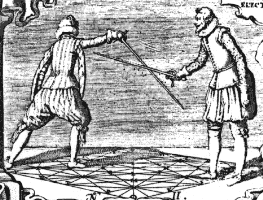
Spanish swordsmen attack and defend by stepping around each other (Compases) along the circumference of the circle. The swordsmen attempt to create an opening in each other's defence by varied changes to the rhythm, tempo, and distance. They attack or defend by stepping, passing, or crossing the circle at angles to each other using chords. Diestros never do this in a linear manner directly at each other. Given their stance, the outcome of impalement by attacking on the diameter would be unavoidable. Narvaez states, "Por la linea del diametro no se puede caminar sin peligro." (Along the line of the diameter one can not walk without peril.)
All attacks, either by cut or thrust, are always executed at an angle to the adversary on either side of the opposing blade. The chords of the circle indicate the angles from which both offensive actions and defensive positioning are the most efficient. The swordsman does not predict the adversary's response. The responses are set up and caused by strategic movement as Narvaez states, "ganando los grados al perfil" (literally, gaining the degrees on the profile, i.e., finding the best position for an attack). This is accomplished by sophisticated footwork which is essential to the mastery of the generalship required in applying the geometry with deadly effectiveness. Narvaez's term for this generalship is "Llave y gobierno de La Destreza" (Key and government of destreza). If the Diestro has accomplished a high level of skill he will be able to command the movements of his adversary by the subtle movements and positioning of his own body. By leading his adversary in this manner the Diestro will be able to create the appropriate angle to launch an offensive action at a moment where his adversary is in a vulnerable position.
The geometry is not solely limited to the illustration and explanation of the spatial relationship between the adversaries. It also applies to the movements and positioning of the weapons. In all of the Spanish treatises it is constantly emphasized that the control of the opposing weapon must be maintained by "atajo" (the taking control of the adversary's blade with one's own, an engagement or opposition).
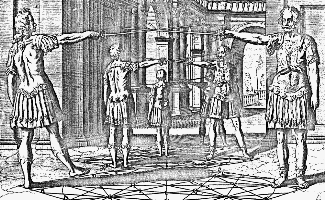
The ability to achieve the atajo is acquired by the Diestro cultivating what was called "tacto" by the Spanish Masters. Tacto can be best described as the tactile feeling sensed in the hand of the swordsman while holding his weapon. This tacto is what enables the Diestro to read the strengths, weaknesses, and intentions of his adversary, on blade contact. (Tacto is in fact the same as the French term "Sentiment du Fer" used in smallsword and foil technique.) In order to achieve this atajo the controlling blade must be placed against the opposed blade at the most efficient position which would ensure the maximum leverage and mechanical advantage. This would be determined by the Diestro's knowledge and application of angles. As Carranza states, "El conoscimeinto que se adquiere con el uso . . . ." (the understanding that is acquired by use) and "Del uso nase el conoscimeinto" (From use comes the birth of understanding). This geometric conceptualization is also applied to the movements of the weapon and how they are executed by the Diestro. If the Diestro raises his sword to make a downward cut, the obtuseness of the angle is determined by the distance and positioning of the adversary as well as the intended target for the cut. The angle of the defending weapon in a counter-offensive action is determined by the angle of the attacking weapon. If the attack is coming towards the head of the Diestro, he can deflect or reroute the attack by raising his weapon to cover the attack while simultaneously offending his adversary with the point of his sword. The knowledge of angles also applies to defensive actions such as Desvio (deflect, parry; literally, to change course). To execute an efficient Desvio the Diestro must place his blade against his adversary's blade in such a manner as to not only deflect the attack but to enable him to counter attack in the same movement. This can only be done correctly if the Diestro has an understanding of angles and the different mechanical advantages achieved by the placement of his blade on the adversary's blade.
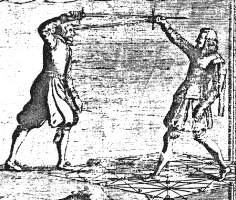
When one is learning a system of fencing or any other martial art, it must be done in a logical progression. It has to be practiced by rote, or "by the numbers". It is with this type of training, that the mind and body are focused and tuned to be able to use the method in applications to the never ending variety of circumstances that can occur in a physical conflict. In no way can every changing situation be predicted in the course of combat. However if the mind and body are trained to size up a situation and react in a logical manner the chances of victory along with survival are increased many times over. This precludes reacting in an uncouth illogical manner derived from the desperation of self preservation. Carranza said: "The vulgar (fencer), although he professes knowledge of swordsmanship, is easy to discover when in times of anger and conflict he forgets his professed skill, committing vulgarity in his manner and action." Carranza also warns that: "If the skill of the swordsman is 'invented' the swordsman in a time of danger is forsaken by his false skill."
The Spanish School has been structured, formal, and uniformly systematized throughout its history. In Italian fencing of the same era there is not a singular "school" but "schools" of swordsmanship all differing in regard to master, city, and region (which persisted into the 20th century). The Italian treatises deal mainly with classification and collections of certain types of attacks (bottas). Consequently the Italian treatises in comparison are much less difficult to understand. The Italian Schools have a more physical (external reactive) approach incontrast to the Spanish which is more conceptual (internal analytical).
The difficulty in understanding La Destreza is that it is a complete system with many levels. It encompasses Science, Art, Experience, Philosophy and Spirituality. These crucial elements can not be viewed out of context, otherwise the entire essence of La Destreza will be lost. The mind set, character, culture, religious, philosophical, and political aspects from which La Destreza emerged must be taken into account. La Destreza is the equal of any of the sophisticated oriental martial arts (along with their socio-cultural aspects) that occidentals have embraced with such awe and reverence. The two main aspects of La Destreza, geometry and philosophy, produce a unique and vastly different manner of thinking creating a cold, calculating swordsman. In any martial art a fighter possessed of these atributes is a formidable force to contend with.
It must be concluded that the manner in which La Destreza has been interpreted by fencing scholars is unjustified. There is absolutely no "mystery" in the Spanish School of Swordsmanship. Nor are there any fantastic, absurd, or arrogant pronouncements on the part of the enlightened individuals that were the founders of the system. More to the point, the questions that must be asked are:
[2] Schacht, John F. and Roderick C. McLennan. Plane Geometry (Henry Holt & Co., 1957) p.v.
2. Capo Ferro, Ridolfo. Gran Simulacro... . Sienna, 1610.
3. Carranza, Don Jeronimo. De la Filosofia de las Armas.... Seville, 1569 -1582.
4. Fabris, Salvator. De lo Schermo, overo scienza d'arme... . Copenhagen, 1606.
5. Narvaez, Don Luis Pacheco de. Libro de las Grandezas de la Espada... . Madrid, 1600.
6. Schacht, John F. and Mclennan, Roderick C. Plane Geometry. Henry Holt and Comapny, Inc., 1957.
7. Girard Thibault in his treatise Academie de l'Espee.... Leyden, 1628.
8. Achille Marozzo. Opera Nova. Venice, 1550.
9. Angelo Viggiani. Lo Schermo. Venice, 1575.
Journal of Western Martial Art
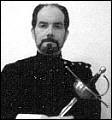 About
the author: is the director of
Martinez
Academy of Arms. He received the rank of fencing master from Maître
Frederick Rohdes in the traditional manner, through years of apprenticeship.
In addition to Maestro Martínez' expertise in the French and Italian
schools, he spent two decades reconstructing the Spanish school of rapier
fence, La Verdadera Destreza. First unveiled to the public at the Aston
Magna Academy, La Destreza has also been demonstrated at Lincoln Center,
The Jarvis Conservatory in Napa, California, and most recently at the International
Paddy Crean Stage Combat Workshop in Edinburgh, Scotland. Maestro Martínez
is a founding member of the International
Masters at Arms Federation, the author of numerous monographs on the
Spanish school, a research consultant for the American
Society for Chivalric Research, and is the president of the Association
for Historical Fencing.
About
the author: is the director of
Martinez
Academy of Arms. He received the rank of fencing master from Maître
Frederick Rohdes in the traditional manner, through years of apprenticeship.
In addition to Maestro Martínez' expertise in the French and Italian
schools, he spent two decades reconstructing the Spanish school of rapier
fence, La Verdadera Destreza. First unveiled to the public at the Aston
Magna Academy, La Destreza has also been demonstrated at Lincoln Center,
The Jarvis Conservatory in Napa, California, and most recently at the International
Paddy Crean Stage Combat Workshop in Edinburgh, Scotland. Maestro Martínez
is a founding member of the International
Masters at Arms Federation, the author of numerous monographs on the
Spanish school, a research consultant for the American
Society for Chivalric Research, and is the president of the Association
for Historical Fencing.